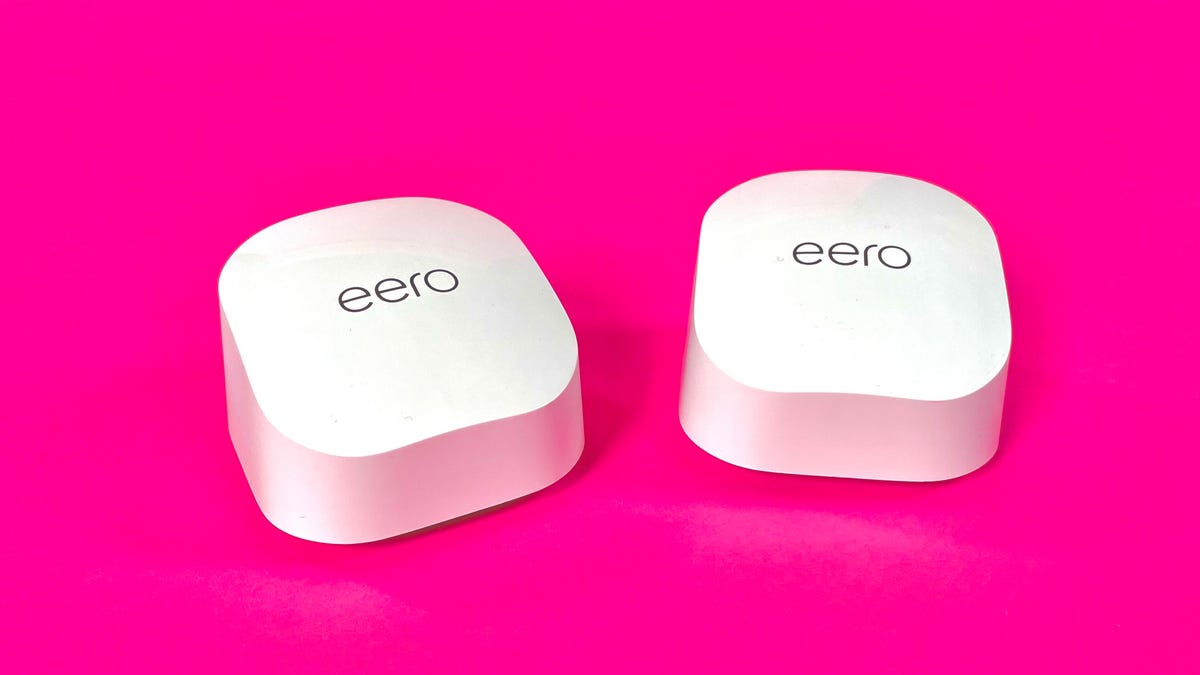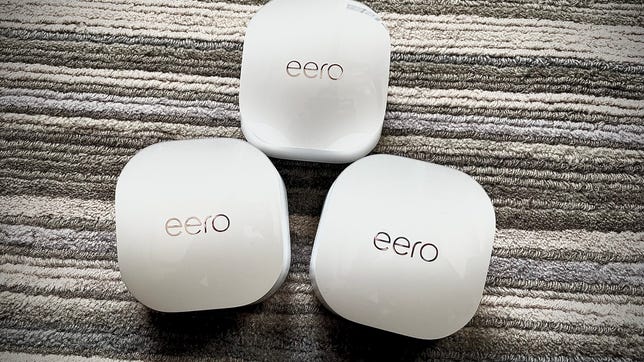

8.3
Eero 6 Plus mesh router
You’re receiving price alerts for Eero 6 Plus mesh router
Like
Simple setup and control via Eero app
Consistent speeds and enough oomph for gigabit networks
160MHz channel support has a positive effect on performance
Matter support and built-in Zigbee hub are great for smart homes
Don’t like
Routing to the wrong extender can cause slight slowdowns
No option to limit Eero’s data collection
Product details
-
Wi-Fi Standard
Wi-Fi 6
-
Speed Rating
AX3000
-
Range
Up to 1,500 sq. ft.
-
Wireless Networking Security
WPA2, WPA3
-
Bands
Dual-Band (2.4 and 5GHz)
Amazon’s Eero 6 had the right ingredients back in 2020, as mesh routers were starting to surge in popularity. The design was simple and inoffensive, the app was disarmingly easy to use, it offered full support for Wi-Fi 6 and, at $279 for a three-pack, it wasn’t terribly expensive. The only problem I had with it was that it made a regular habit of routing my connection through the wrong extender at the wrong time during my battery of performance tests, which caused its average speeds to deflate like a defeated soufflé.
Now, Amazon is back, and it seems to have beaten the eggs a bit better than before. The new Eero 6 Plus system still isn’t perfect at steering connections through the best extender for the job, but few mesh routers are (particularly dual-band systems like the 6 Plus), and this time, the issue is much less severe. Overall, it’s much improved and much easier for me to recommend, especially at its current price of $255.
Part of that is simply because it didn’t happen quite so often, but you can also thank the new support for 160MHz channel width, up from 80MHz last time around. That’s the key part of the Plus pitch, and it means that the system can now move data twice as efficiently to 160MHz-compatible devices, of which there are many. Even without devices like that on your network, you’ll still benefit from the faster connection between the Eero devices themselves. That, combined with a faster-than-before AX3000 build, means that your speeds won’t drop as much if the Eero 6 Plus routes your connection through an extender that’s three rooms away instead of one that’s one room away.
That was my experience at home, where I put the Eero 6 Plus through the same spate of tests that the Eero 6 went through two years ago. Last time around, a huge disparity in performance between the tests where I connected close to the router versus those where I connected far from it caused the system to return download speeds throughout my house that averaged just 196 megabits per second, which isn’t great for a 300Mbps fiber network, where the fastest devices I test tend to max out at about 375Mbps at close range. The Eero 6 Plus cranked that whole-home average all the way up to 304Mbps. That’s top 10 among the 30 or so mesh routers that I’ve tested at home over the past few years — and none of the systems that beat its speeds can beat its value.
All of that makes the Eero 6 Plus an excellent choice for anyone looking to upgrade to Wi-Fi 6 or to a mesh network. That’s especially true if you live in a multistory home, where that third device would prove particularly useful (the other noteworthy Wi-Fi 6 system I recommend in this $200-$300 price range, the TP-Link Deco W7200, only nets you two devices instead of three). A strong smart home acumen via Amazon’s “frustration-free” setup, support for the upcoming Matter protocol and the built-in Zigbee radio for pairing things like lights and locks with your network are just the icing on the cake (or the sauce on the soufflé, if you will). Bottom line: The Eero 6 Plus keeps everything that the Eero 6 got right, and it executes on the promise of strong, consistent speeds much better than before.
Design, specs and app controls
Available now at $255 for a three-pack, $204 for a two-pack or $119 for a single device, each Eero 6 Plus unit is identical, so you can use any of them as either an extender or the main router of the system. They’re 99% identical to the Eero 6 devices that came before them, too — the same glossy white plastic, the same curved design, the same solo indicator light (white means all right, blue means pairing mode and red means “uh oh”). I wouldn’t fault anyone for calling the things uninspired, but they aren’t ugly or bulky or cheap-looking, and they shouldn’t have much trouble blending in with most home decor.
Each Eero 6 Plus device features a pair of gigabit Ethernet ports in the back, plus the USB-C power jack.
As for the hardware inside, the Eero 6 Plus boasts an AX3000 build, which is up from AX1800 with the first-gen Eero 6. The AX part tells you that the router supports 802.11ax, or Wi-Fi 6; the number after it tells you the combined top speeds of each of the bands (2.4GHz and 5GHz). Though I haven’t had the chance to test it out on a gigabit network yet, an AX3000 speed rating is more than enough to top out a connection like that. Meanwhile, the system powers those radios with a 1GHz dual-core processor, 512MB of RAM and 4GB of storage. As for range, Amazon says that a three-piece setup should be enough to cover up to 4,500 square feet.
You’ll find your ports in the back — namely, the USB-C power jack and two gigabit Ethernet ports on each device. Those Ethernet ports set a speed limit for the incoming connection, so if you’re thinking about upgrading to a multigig internet plan sometime soon, then you’ll want to skip the 6 Plus and consider spending more to get the Eero Pro 6E, or another router with a multigig Ethernet jack capable of handling speeds like those (the Asus ZenWiFi XT8, the TP-Link Deco X90 and the Netgear Orbi AX6000 are all well-reviewed models that fit the bill).
This brings us to Eero’s app, which you’ll use to set the system up, monitor its performance and adjust its settings. With a nice-looking design and intuitive access to controls and settings, it’s one of the better app options in the router category, and it makes quick work of the setup process. Just tap your way through the instructions, plug things in when instructed to, pick out a network name and password and update to the latest firmware build, and your network will up and running in a matter of minutes.
From there, you’ll be able to use the app to see which devices are connected to your network, or group them into specific profiles for purposes like ad blocking and parental controls. The app also makes it easy to track your speeds and your data usage, which is particularly helpful if your internet plan comes with a data cap. You can turn on WPA3 encryption in the Eero Labs section of the app for the latest in network security and, if you like, you can subscribe to Eero Secure Plus for advanced options for ad blocking and threat detection, plus access to additional services like 1Password and the Encrypt.me VPN.
As for privacy, Eero’s support page explains that it doesn’t track the websites you visit or the contents of your network traffic, though the company does collect network data to help maintain and improve system performance. Some of that data includes personal data from the app, like your email and device IP addresses, but the company draws some lines with how that information gets used.
“We don’t sell our customer data, and we don’t sell ads based on this data,” the support page reads. “We collect data about your Eero network to help us optimize your Wi-Fi performance.”
Other manufacturers offer an option to limit data collection or opt out of it altogether, but there’s no such option with Eero. Additionally, per the company’s privacy policy, you can email to request deletion of your personal data, but doing so means you won’t be able to use your Eero devices anymore. None of that would stop me from using the system in my home, but if you’re especially privacy-conscious and trying to limit data collection among your devices as much as you can, Eero probably isn’t the best fit.
Among all of the mesh routers I’ve tested at my home, the Eero 6 Plus was a top-10 finisher in terms of average download speeds. (Routers listed with stars were tested prior to Wi-Fi 6, with a Wi-Fi 5 client.)
Performance and speed
To get a sense of just how much “Plus” we’re talking about here, I tested the Eero 6 Plus at my home in Louisville, Kentucky, the same place where I tested the Eero 6 system two years ago. It’s a 1,300-square-foot home, and I tested it on the same 300Mbps fiber internet plan, though the true speed limit seems to be more like 375Mbps. Once I’ve had a chance to test the system out in the much larger CNET Smart Home, I’ll update this section with some additional data.
I saw slower average download speeds in the middle of my house when I’d start my connection in the back bathroom, closer to the extender than the router (yellow bars). That’s because the system was continuing to route me through the extender as I moved toward the living room even though switching me over to the router would have been faster.
With the router set up in my front-of-house living room and a single extender hooked up in the back-of-the-house bedroom, I spent a few days running speed tests across five rooms, following the same procedure for testing routers that I always use. One key point of my methodology: I run multiple rounds of tests across multiple days of testing, and I split those rounds into two groups — ones where I start with a fresh connection in the living room, near the router, and ones where I start my connection in the back of the house near the extender. Doing so gives me a good look at how the system adjusts my connection as I move from room to room.
When I tested the Eero 6, those two sets of tests produced hugely different results. My speeds were fine when I started my connection in the living room and worked back, but if I started in the back of the house and worked my way to the front, it would route my connection through the extender even after I’d returned to the living room, with the router just a few feet away. I saw some of that same issue with the Eero 6 Plus, but the resulting slowdowns were much less drastic, and, typically, by the time I reached the living room in those back-to-front tests, the system would realize it and begin routing my connection straight to the nearby router.
Consequently, the Eero 6 Plus finished with much stronger average speeds than the Eero 6 did. Overall, its average download speed to my Wi-Fi 6 test laptop was 304Mbps, where it was only 196Mbps with the Eero 6. The system’s average upload speed was slightly less impressive at 253Mbps, but that’s still a fine result — better than the 204Mbps I saw from the Eero 6, and better than well-reviewed systems like the TP-Link Deco W7200 (248Mbps), Nest Wifi (230Mbps) and Asus ZenWiFi XD6 (224Mbps). Speeds were predictably a bit slower but still decent when I ran my tests to a Wi-Fi 5 client device, too — average downloads of 288Mbps and average uploads of 208Mbps. Only five systems did better than that in my at-home tests, and all of them are costlier tri-band systems.
The Eero 6 Plus delivered sturdy average wireless speeds on a gigabit network, but fancier systems like the Eero Pro 6E, the Netgear Orbi AX6000, and the TP-Link Deco XE75 can do better.
What about gigabit speeds?
I recently upgraded my home’s fiber network from that 300Mbps connection to a gigabit connection, with max download speeds of 940Mbps and max upload speeds of 880Mbps. Those are the speeds that I’ll be using for my router tests moving forward, so I made sure to retest the Eero 6 Plus.
Watch this: Which Router Upgrade Is Right for You?
Testing across the same five spots in my home, the system finished with average download speeds of 427Mbps and average upload speeds of 380Mbps. That’s slightly better than the TP-Link Deco W7200, one of my top overall mesh router recommendations, but slower than fancier systems that cost more, including the Eero Pro 6E, the Netgear Orbi AX6000 and the TP-Link Deco XE75. All three of those were able to push my average downloads well above 500Mbps.
Still, even if it isn’t as capable of taking advantage of a gigabit connection as some systems are, the Eero 6 Plus nets you great performance for the price — and I was pleased that, once again, the band-steering issues were quite limited. It’s a better pick for, say, a 500Mbps network, but even with a gigabit connection, your home’s Wi-Fi will feel plenty fast with the Eero 6 Plus.
Now we’re cooking
I have tasted the Eero 6 Plus soufflé — it’s fluffy and satisfying.
Overcooked metaphors aside, this is an excellent mesh system for the money, and a strong step up from what the Eero 6 initially had to offer. Setup is a cinch thanks to the Eero app, and performance held tall across multiple days of tests. Smart home users should appreciate the built-in Zigbee radio, and users of all kinds will benefit from the system’s ability to move more data at once than before.
At $255 for a three-pack, there’s plenty of value here, particularly given that a lot of other top-performing systems cost more for a two-pack. Since the system is backward-compatible with previous generations, I also like the idea that people who already own an Eero system can pick up a 6 Plus device whenever those go on sale and swap it into their setup. Either way, the Eero 6 Plus is well worth considering, and a great option for anyone looking for a faster connection at home.

